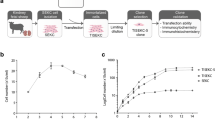Abstract
A cell line derived from the urothelium lining the ureter of a 12-year-old girl was immortalised using a temperature-sensitive SV40 large T-antigen gene construct, and designated UROtsa. Following immortalisation, UROtsa cells expressed SV40 large T-antigen, but did not acquire characteristics of neoplastic transformation, including growth in soft agar or the development of tumours in nude mice. Metaphase spreads had a normal chromosomal appearance and number. UROtsa cells remained permissive for cell growth at 39°C, indicating that they did not retain temperature sensitivity. UROtsa provides an in vitro model of “normal” urothelium.
Similar content being viewed by others
References
Bookland EA, Swaminathan S, Oyasu R, Gilchrist KW, Lindstrom M, Reznikoff CA (1992) Tumorigenic transformation and neoplastic progression of human uroepithelial cells after exposure in vitro to 4-aminobiphenyl or its metabolites. Cancer Res 52:1606
Christian BJ, Loretz LJ, Oberley TD, Reznikoff CA (1987) Characterization of human uroepithelial cells immortalized in vitro by simian virus 40. Cancer Res 47:6066
Hayflick L (1965) The limited in vitro lifespan of human diploid cell lines. Exp Cell Res 37:614
Jat PS, Sharp PA (1989) Cell lines established by a temperature-sensitive simian virus 40 large-T-antigen gene are growth restricted at the nonpermissive temperature. Mol Cell Biol 9:1672
Kao C, Wu S-Q, De Vries S, Reznikoff WS, Waldman FM, Reznikoff CA (1993) Carcinogen-induced amplification of SV40 DNA inserted at 9q12-21.1 associated with chromosome breakage, deletions, and translocations in human uroepithelial cell transformation in vitro. Genes Chromosom Cancer 8:155
Meisner LF, Wu S-Q, Christian BJ, Reznikoff CA (1988) Cytogenetic instability with balanced chromosome changes in an SV40 transformed human uroepithelial cell line. Cancer Res 48:3215
Pazzaglia S, Chen XR, Aamodt CB, Wu S-Q, Gilchrist KW, Oyasu R, Reznikoff CA, Ritter MA (1994) In vitro radiation-induced neoplastic progression of low-grade uroepithelial tumors. Radiat Res 138:86
Petzoldt JL, Leigh IM, Duffy PG, Masters JRW (1994) Culture and characterisation of human urothelium in vivo and in vitro. Urol Res 22:67
Pratt CI, Wu S-Q, Bhattacharya M, Kao C, Gilchrist KW, Reznikoff CA (1992) Chromosome losses in tumorigenic revertants of EJ/ras-expressing somatic cell hybrids. Cancer Genet Cytogenet 59:180
Reznikoff CA, Loretz LJ, Christian BJ, Wu S-Q, Meisner LF (1988) Neoplastic transformation of SV40-immortalized human urinary tract epithelial cells by in vitro exposure to 3-methylcholanthrene. Carcinogenesis (Lond) 9:1427
Reznikoff CA, Kao C, Messing EM, Newton M, Swaminathan S (1993) A molecular genetic model of human bladder carcinogenesis. Semin Cancer Biol 4:143
Author information
Authors and Affiliations
Rights and permissions
About this article
Cite this article
Petzoldt, J.L., Leigh, I.M., Duffy, P.G. et al. Immortalisation of human urothelial cells. Urol. Res. 23, 377–380 (1995). https://doi.org/10.1007/BF00698738
Received:
Accepted:
Issue Date:
DOI: https://doi.org/10.1007/BF00698738




